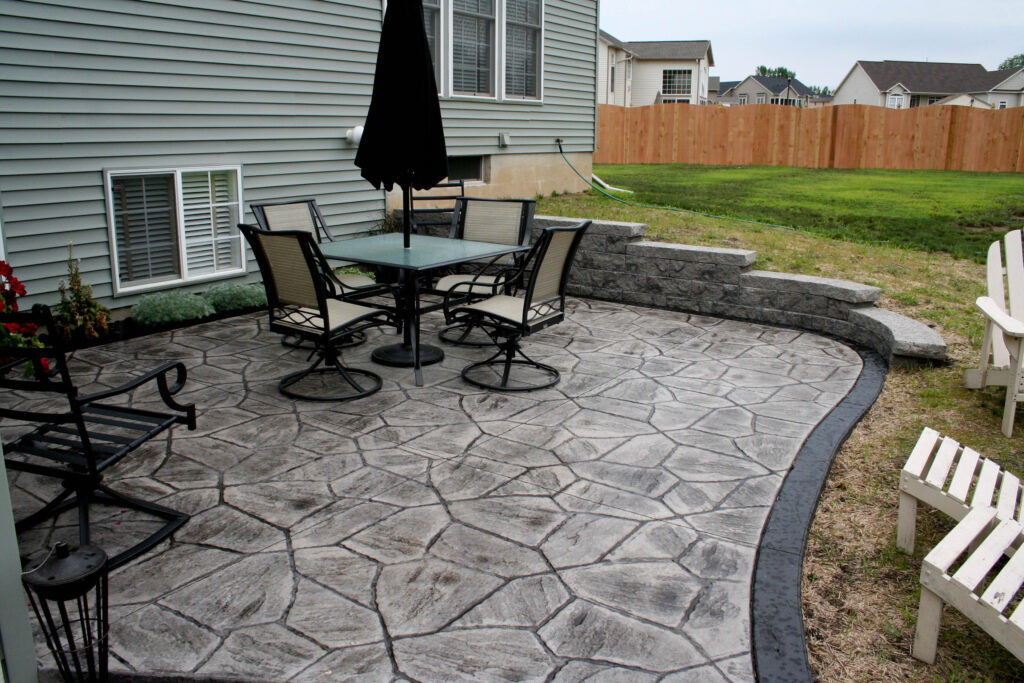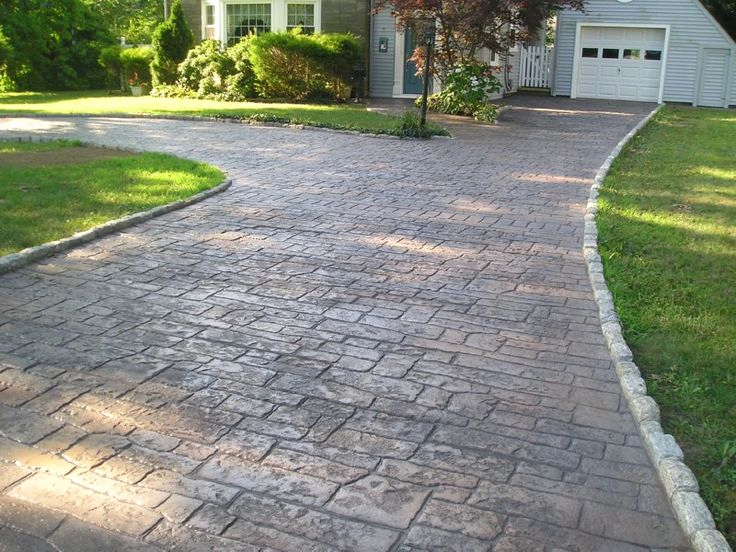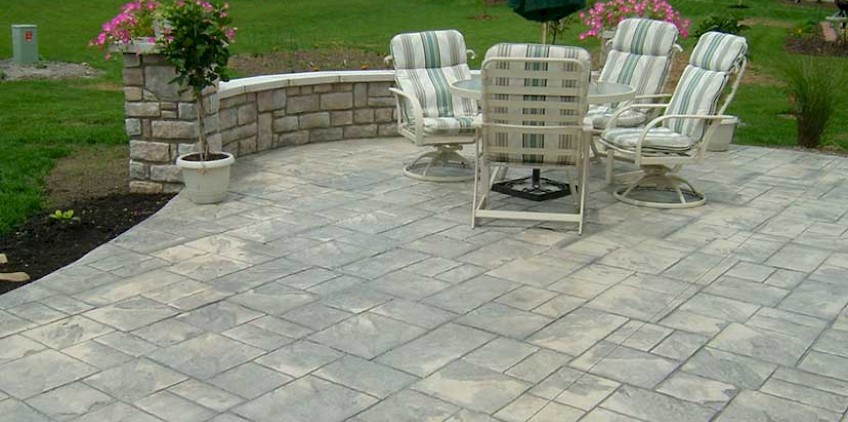
Stamped Concrete Patio
The patio is an extension of the indoor living room. It should be appealing and comfortable enough for unwinding after a busy day. We highly recommend installing a stamped overlay on an existing patio to give it a new look and extend the life of the slab. Choose a design that effectively imitates the look of wood or stone without the high cost!

Stamped Concrete Driveway
The driveway plays a huge role in enhancing a property’s curb appeal. It is crucial to acquire an appealing surface without compromising safety. That is exactly what stamped concrete is here for. It can recreate the look of a luxurious driveway at a more affordable cost. A stamped pattern provides enough traction to make it a safe option, especially for sloped driveways.

Stamped Concrete Pool Deck
Remember how the pool deck used to have tiles on its surface? When wet, the tiles became slippery and very unsafe to walk on. Nowadays, one of the most highly recommended options for pool decks is a stamped concrete overlay. It provides sufficient slip-resistance and a comfortable surface to walk on even with bare feet.
5-Day Stamped Overlay Installation
A professional concrete contractor can install a stamped overlay in approximately 5 days.
Here is a rough summary of how the process goes.
Day 1
We power wash the surface and clean it thoroughly.
Day 2
While the surface air dries, the surroundings are masked and protected to make sure that the product does not affect anything but the concrete slab. We mix a primer coat and trowel it down on the concrete surface.
Day 3
We prepare the stamped overlay mix and then apply it to the prepared slab. We incorporate the design on the overlay before it dries and hardens.
Day 4
The overlay is left to sit and dry.
Day 5
If the customer requests it, we stain and seal the concrete after the overlay has cured completely.
ProLawn & Landscaping creates highly decorative solutions that combine form and function to bring your concrete back to life. We provide our clients with a detailed scope of stamped concrete work and custom patterns to give you a glimpse of what we have to offer. From pattern to colors, our team will guide you through the selection process.
Care and Maintenance of Your Concrete
We recommend you seal your concrete.
Sealing the concrete protects the surface from damage caused by road salts and brine used by the highway department during winter driving conditions.
Even calcium-coated salts, liquid salts, and other ice-melting products have the potential to damage the surface, causing scaling, spalling, and delamination. Damage is more visible on broom finished and stamped concrete surfaces. Although exposed aggregate finishes become damaged too, the damage is not as obvious.
Would you like a better solution than salts and ice-melting products? Carefully remove the snow from the surface. Use cat litter or sand for walking traction on the remaining snow and ice. Be aware that snow shovels can gouge the surface and leave permanent marks. Also, snow removal with tractors or skid steer loaders can leave damage to the surface.
Sealer also protects the surface from damage caused by the sun’s UV rays and staining from leaves, silt, rust, bird droppings, dripped oil, transmission fluid, and antifreeze from cars.
Broom finish is created by running a stiff bristled broom over the soft concrete, making grooves perpendicular to the general traffic direction. This provides good traction. For Broom finished concrete, use a penetrating sealer. This type of sealer dries to a clear finish.
Exposed aggregate concrete is a decorative concrete created by removing the top layer of cement paste and exposing the aggregate below it. For exposed aggregate finished concrete, use a 25% or 30% gloss sealer with either clear or brown tone.
For stamped finished concrete the sealer chosen depends on the actual finish that has been applied to the concrete.
You can apply the sealer yourself. Or if you like, we will be glad to let you know the price for us to apply the sealer for you.
The sealer should be re-applied occasionally when it begins to wear off the surface. On average, your stamped concrete should be resealed every two to three years.
Keep your concrete clean by performing regular washings, especially in the winter when temperatures permit.
If the concrete cracks, paving joint sealers can be used to seal the cracks. These come in a variety of colors making it possible to use a color that matches or blends well with the color of the concrete.
By properly caring for and maintaining your concrete, you will add many years of useful life to it as well as insuring that it will continue to look its best. If you have any questions about care and maintenance, please feel free to contact me by phone or email.
Which is a Better Patio Material – Stamped Concrete or Pavers?
This is currently a debate in the hardscaping world. Both are durable, relatively affordable, and look great. That’s probably why consumers find them to be the two most popular options on the market today. But which is better? Let’s discuss the pros and cons of each so you can decide for yourself.

Stamped Concrete Advantages
- Cost: Usually priced between $8-$15 per square foot, depending on the size, pattern, and application.
- Many patterns to choose from: Flagstone, textured stone, slate, brick, and cobblestones are some of the most popular patterns.
- Variety of Colors: Stamped concrete is often composed of at least two colors, a base color that is mixed into the concrete or troweled into the surface and a second color called a release agent that is broadcasted on top of the concrete just before stamping. The relationship of these two colors is what gives stamped concrete it’s unique, antique look.
- Looks like the real thing: It has the appearance of slate, flagstone, or brick for a fraction of the cost of the natural material.
- Sealed Protection: Stamped concrete is sealed which protects it from the elements as well as pool chemicals such as salt from salt water systems.
Stamped Concrete Disadvantages:
- Possible Cracks: It’s concrete so it will crack. There are two kinds of concrete – the kind that cracked and the kind that is going to crack! It is our job to place control joints to cause the concrete to crack where we want it to crack, but sometimes concrete cracks where it wants to. The only way to guarantee no cracks is not to get stamped concrete!
- Color Variations: If more than one truck load of concrete is required, there is no guarantee that the colors of the two trucks will match perfectly. We can use a color hardener powder as an additional option to help keep this from happening.
- Resealing and Coloring: The sealer needs to be re-applied every 2 to 3 years to make it look brand new again.
- Slippery: The surface can be somewhat slippery without the addition of an anti-skid agent (shark grip) mixed with the sealer or speckled sand under the sealer. This can be an additional option to help prevent it from being slippery.

Paver Advantages:
- Cost: Usually costs anywhere between $12-$20 per square foot depending on the size and style that you choose.
- No Cracking: Pavers won’t crack if installed correctly.
- Expanding Patio or Walkway: Paver patios or walkways can easily be added to in the future.
- Easy to fix: If underground repairs are needed, a seamless fix is possible.
- Not slippery unless sealed, which is seldom done around pools.
Paver Disadvantages:
- Sinking: There’s a possibility that they will settle and move over time, especially in areas where there was extensive backfill or new construction.
- Weeds: Weeds can grow up between pavers unless polymeric sand is used. This is sand with a polymer additive that causes it to bind together between the pavers and harden. It prevents weeds but needs to be re-applied every couple of years.
- Limited Colors: Color and pattern selections for pavers are more limited than stamped concrete options.
- Color Variations: There can be unwanted variation in color of the product, even between different pallets of material from the same truck.
- Timing: Installing pavers typically takes longer than installing concrete.
You may ask, “So which one do you prefer?”
Asking me if I prefer stamped concrete or pavers is like asking me if I would rather have vanilla or chocolate ice cream. The answer is, “Both.” But sometimes there are situations that call for a certain one.
A few things to consider are the compatibility of the material with existing elements of the yard. Can you find a color that fits your surroundings? Do you plan to expand the patio in the near future? One thing’s for sure, with the durability and beauty of both these patio materials, it’s hard to go wrong.
